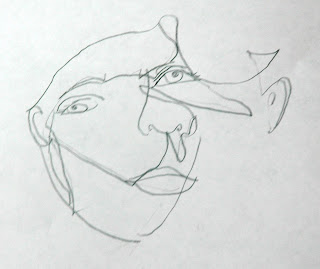A billboard on I-75 advertising the Appleton Art Museum in Ocala, Florida reads “Connecting Art with Life.” That is what I have always wanted to do for my students, but have often been frustrated because I did not know quite how to do it. However, I truly believe that the new way of thinking about curriculum which has been shown to me this semester will help me make them realize how art throughout history, and the making of new art, is relevant to their lives, whether or not they decide to become artists later on.
Many of the big ideas I have been introduced to as foundations for curriculum building are ideas I have been interested in, and think about as I go about my daily life as well as while making art. However, I had never really thought about making them a main part of my teaching. The concept of organizing lessons around a big idea is exciting, and developing an entire curriculum based on one big idea has been very satisfying. Doing so shows students that the ideas behind all great pieces of art unifies them, which is part of what makes the art itself timeless. It also shows them that the ideas are bigger than merely the art world, but extend to other fields, as well as issues that they individually deal with in their world today.
I have been impressed by how much more complex and interesting a lesson plan is when you base it on student problem solving and student choices rather than a step-by-step process that produces a predictable result. These emphases connect art with life in that they teach students about a part of life that is key: making choices and solving problems. This is something we do every day, no matter what our walk in life. It seems to me an art curriculum that recognizes this, and helps students to think more critically, would be much more effective and relevant in the life of a student than one focused merely on skill-building.
At first, this seemingly more open-ended approach looked as though it would leave little room for skill building. However, I have learned that I do not need to throw skill-building out of the window, but it is actually something I should incorporate while I am teaching the big idea. This also helps connect art with life, because it helps students see that skills they are learning connect directly to the big idea they are exploring as they do their problem solving, since the skills help the students to accomplish the task before them. It enables me to be somewhat rigorous about teaching the skills, too, as long as I give students clear expectations, showing them and teaching them how to do each skill, one at a time. Too often I have expected students to intuitively know how to handle different media, doing things such as blending and shading without including those skills in my lesson. This has caused a gap between my assessment and my instruction. That is one area in which I need to improve. I also need to make sure I slow down and show them what I expect. Just because I know what I’m looking for does not mean that they do.
The new ways of teaching art that I have learned about this semester have added a new dimension to the way I think about teaching art, and I know they will have a huge impact on my teaching. A good teacher is one who explores his field alongside his students. I feel that the mindset that has been presented to me as I have taken this course will move me toward becoming a better teacher in this way, and this excites me.
Thursday, June 19, 2008
Tuesday, June 17, 2008
Moving Toward Conceptual Curriculum Planning
When I started putting together my first curriculum, I thought that a helpful bit of information to consider would be my recollection of the art projects I did when I was in school. However, to my dismay, I could not remember many of the art lessons I had as a student. Most of my art education experience in the Florida Public School system is pretty much a blur.
I resorted to talking to friends of mine who were seasoned teachers. They gave me books and pages of old lesson plans which ended up becoming a starting point for my curriculum planning. The two themes I saw in all of these lessons were a chronological presentation of art history, and the elements and principles of design. These two ideas have formed the framework of my curricula ever since I have started teaching art. One thing I liked most about these frameworks is that they made it very easy for me to decide what to do next. After a lesson on Lascaux cave paintings, it was obvious that Ancient Roman art would be a good place to go. By the same token, a project focusing on shape naturally follows a lesson on line.
This seemed to work fine for a couple of years, especially since the elements and principles were new concepts to me (I hadn’t covered them in my music degree), and art history was so exciting in itself. I really thought it was quite an accomplishment to get them to interact with historical art, even if they were producing their own piece in the style of a Van Gogh, or copying a Monet. And if I could get them to think about the way art can be broken down into elements, and how to critique art according to principles, I thought I would be satisfied. But there were many times when I wished that my students’ artmaking experience could be more like mine is—an organic process of creation. I found so much more satisfaction in teaching independent projects some of my students would do when participating in county-wide and nation-wide contests than I did teaching my normal classes, because I could talk with each of them and help them to come up with ideas that were relevant to their interests, and that inspired them to create.
Why was it that I eventually enjoyed teaching my curriculula so much less than these individual projects? In retrospect, I think my frustration with my curricula lied in its exclusion of the first part of the creative process: generating ideas. Many of the projects in my lessons were primarily mimetic. Maybe I was either assuming I could not teach it, or I was assuming that my students could not do it. Maybe I was considering the technical aspects of the art-making process to be more important to teach than the creative thinking aspects. The consequence is that many of my students have difficulties coming up with ideas when I leave projects more open-ended. This is something that I intend to fix as I write my new curriculum. It is true that the technical side of art is much more straightforward, and it is difficult to make good art with little technical skill. However, without the ability to come up with an idea, what good is technical skill to an artist? Therefore, my key concept for my students to explore will be “Where do artists get their ideas?”
I resorted to talking to friends of mine who were seasoned teachers. They gave me books and pages of old lesson plans which ended up becoming a starting point for my curriculum planning. The two themes I saw in all of these lessons were a chronological presentation of art history, and the elements and principles of design. These two ideas have formed the framework of my curricula ever since I have started teaching art. One thing I liked most about these frameworks is that they made it very easy for me to decide what to do next. After a lesson on Lascaux cave paintings, it was obvious that Ancient Roman art would be a good place to go. By the same token, a project focusing on shape naturally follows a lesson on line.
This seemed to work fine for a couple of years, especially since the elements and principles were new concepts to me (I hadn’t covered them in my music degree), and art history was so exciting in itself. I really thought it was quite an accomplishment to get them to interact with historical art, even if they were producing their own piece in the style of a Van Gogh, or copying a Monet. And if I could get them to think about the way art can be broken down into elements, and how to critique art according to principles, I thought I would be satisfied. But there were many times when I wished that my students’ artmaking experience could be more like mine is—an organic process of creation. I found so much more satisfaction in teaching independent projects some of my students would do when participating in county-wide and nation-wide contests than I did teaching my normal classes, because I could talk with each of them and help them to come up with ideas that were relevant to their interests, and that inspired them to create.
Why was it that I eventually enjoyed teaching my curriculula so much less than these individual projects? In retrospect, I think my frustration with my curricula lied in its exclusion of the first part of the creative process: generating ideas. Many of the projects in my lessons were primarily mimetic. Maybe I was either assuming I could not teach it, or I was assuming that my students could not do it. Maybe I was considering the technical aspects of the art-making process to be more important to teach than the creative thinking aspects. The consequence is that many of my students have difficulties coming up with ideas when I leave projects more open-ended. This is something that I intend to fix as I write my new curriculum. It is true that the technical side of art is much more straightforward, and it is difficult to make good art with little technical skill. However, without the ability to come up with an idea, what good is technical skill to an artist? Therefore, my key concept for my students to explore will be “Where do artists get their ideas?”
Thursday, May 29, 2008
Reflecting on "The Conversation Game"
Since it is the end of the year, I will not at this point be able to use "The Conversation Game" in the way I would like to. It appears to be very useful in helping students generate ideas, and showing them that ideas for art can come from all of life. Ideally, we would play this game at least four times throughout the semester, and students would also use their sketchbook and journal entries to build up a collection of ideas from which they can draw (no pun intended).
My seventh graders played the game this morning. They enjoyed it very much, and I wasn't surprised. Of course, I don't know of many middle school students that wouldn't enjoy a game centered on talking with other students. Instead of verbally sharing the questions with each other at the end, they wrote them on the board. Here are some of the questions they wrote:
"If you could change your name, what would it be?"
"Where is your favorite campsite?"
"What is your favorite sport, and why?"
"What are you going to do over the summer?"
"If you could live in any time period, what would it be?"
Although I had an overall positive response from my students, and they came up with creative questions and answers which could easily contribute toward artistic inspiration in the future, I am not sure how well this works as a game. Our game this morning ended in a tie, since no two groups came up with the same question. At this point, I would like to try to add an element to this game.
My seventh graders played the game this morning. They enjoyed it very much, and I wasn't surprised. Of course, I don't know of many middle school students that wouldn't enjoy a game centered on talking with other students. Instead of verbally sharing the questions with each other at the end, they wrote them on the board. Here are some of the questions they wrote:
"If you could change your name, what would it be?"
"Where is your favorite campsite?"
"What is your favorite sport, and why?"
"What are you going to do over the summer?"
"If you could live in any time period, what would it be?"
Although I had an overall positive response from my students, and they came up with creative questions and answers which could easily contribute toward artistic inspiration in the future, I am not sure how well this works as a game. Our game this morning ended in a tie, since no two groups came up with the same question. At this point, I would like to try to add an element to this game.
Some Thoughts on "The Conversation Game"
While writing a new art curriculum, in search of a way for my students to explore where artists get their ideas, I came upon “The Conversation Game,” which was developed by Marvin Bartel, Ed. D. Follow this link to see the lesson: http://www.goshen.edu/art/ed/self.html In the article accompanying the lesson, he wrote about one of his biggest challenges as a teacher:
“I had a problem. I was good at teaching skills, but teaching technicians was not enough. My teaching needed to find ways to communicate this autobiographical nature of art to students in a way that made their own mind, soul, experience, and values available to them and more important to them. Just assigning this was not enough to see it happen. I know there are those who say art cannot be taught, but that did not keep me from trying.”
I have been wondering how I could inspire my students and teach them to get excited about coming up with their own ideas. It sounded to me like this teacher was on the same wavelength. One focus that I have found to be particularly helpful in area is getting students to ask questions. I have mostly explored different ways of getting students to ask questions about artwork. However, the goal of the Conversation Game is to get students to ask questions about each other.
“When students practice the ability to form questions, they are exercising their critical thinking abilities and skills. Learning to ask good questions is learning critical and artistic thinking habits.” Until reading this article, I have been thinking of art as a catalyst for asking questions, not the other way around. Although I have heard artists refer to their artwork as being explorations of ideas and concepts, I hadn’t thought about the fact that this was necessarily advantageous to the artist.
Dr. Bartel stresses the fact that artistic ideas come from all of life, and they come when you least expect it. Part of coming up with great ideas is learning to take a real interest in life, and a great place to start is taking interest in the lives of others. Central to this game is asking questions about other students’ lives, and points are awarded for coming up with the most original questions. I think this approach to teaching creative thinking would be successful, since students might not be as prone to getting bogged down by a supposed need to come up with some grand idea out of thin air. It shows them in a very practical way how one idea can lead to another, and how great ideas start from talking, thinking about, and living everyday life. I also like the fact that it helps the students think outside of their own world, and become interested in someone else’s. This is something that I think we especially need to strive to teach at the middle school level. I am going to use this lesson today with my 6th and 7th grade classes, and am excited to see how it works out. In the future, I intend to use this toward the beginning of the school year.
“I had a problem. I was good at teaching skills, but teaching technicians was not enough. My teaching needed to find ways to communicate this autobiographical nature of art to students in a way that made their own mind, soul, experience, and values available to them and more important to them. Just assigning this was not enough to see it happen. I know there are those who say art cannot be taught, but that did not keep me from trying.”
I have been wondering how I could inspire my students and teach them to get excited about coming up with their own ideas. It sounded to me like this teacher was on the same wavelength. One focus that I have found to be particularly helpful in area is getting students to ask questions. I have mostly explored different ways of getting students to ask questions about artwork. However, the goal of the Conversation Game is to get students to ask questions about each other.
“When students practice the ability to form questions, they are exercising their critical thinking abilities and skills. Learning to ask good questions is learning critical and artistic thinking habits.” Until reading this article, I have been thinking of art as a catalyst for asking questions, not the other way around. Although I have heard artists refer to their artwork as being explorations of ideas and concepts, I hadn’t thought about the fact that this was necessarily advantageous to the artist.
Dr. Bartel stresses the fact that artistic ideas come from all of life, and they come when you least expect it. Part of coming up with great ideas is learning to take a real interest in life, and a great place to start is taking interest in the lives of others. Central to this game is asking questions about other students’ lives, and points are awarded for coming up with the most original questions. I think this approach to teaching creative thinking would be successful, since students might not be as prone to getting bogged down by a supposed need to come up with some grand idea out of thin air. It shows them in a very practical way how one idea can lead to another, and how great ideas start from talking, thinking about, and living everyday life. I also like the fact that it helps the students think outside of their own world, and become interested in someone else’s. This is something that I think we especially need to strive to teach at the middle school level. I am going to use this lesson today with my 6th and 7th grade classes, and am excited to see how it works out. In the future, I intend to use this toward the beginning of the school year.
Monday, April 28, 2008
Regular Contour Drawings
These are some regular contour drawings my students did a couple of weeks ago. Although some of them really enjoyed blind contour drawing, most students let out a sigh of relief when I told them they didn't have to draw with a shield over their hand. I think the blind contour drawing helped them to draw more of what they actually saw, rather than what they thought they saw--even when they were allowed to look at their paper (I did stress, however, that they should be looking at their subject 90% of the time).
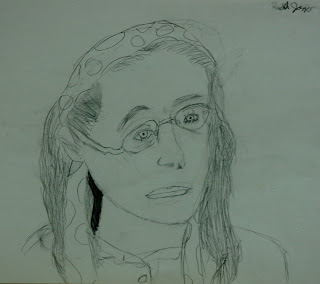
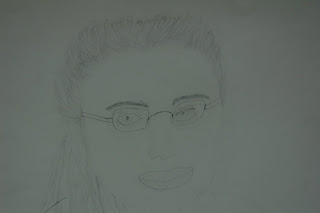




Friday, April 25, 2008
Letter to An Artist
Yesterday, each of my students picked an art print from our classroom print collection and wrote a letter to the artist of the painting reproduced.
Here are a few of their letters:
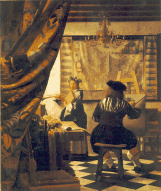
Dear Johannes Vermeer,
I love your painting! The colors brown and red sit very well together. Is that supposed to be you painting in the picture?
I think the way you put such a detailed picture in the background is an awesome idea! Was this back when Spain still hadn’t found America? I think that your painting of another painting was a brilliant idea!
Sincerely,
Jasmine

Dear Mr. Hopper,
I love your work (November, Washington Square). It is a very realistic looking picture. I like how it shows real American life at that time.
This picture is of a city so you should do one of the country out west. I also like how the sky is painted with the blue in the middle. I think you are great at painting cities.
Sincerely,
Carrie
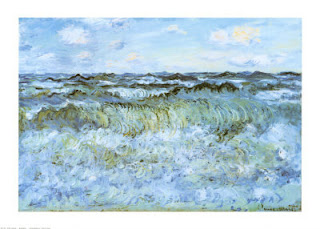
Dear Mr. Monet,
Why did you choose all those bluish colors? Were you sad about someone dying at sea? I like the colors you chose for this particular painting.
Were you angry when you painted this? All of your strokes look like they were done in anger, or in a rush. Get back to me on that, okay?
Sincerely,
Rachel
Here are a few of their letters:

Dear Johannes Vermeer,
I love your painting! The colors brown and red sit very well together. Is that supposed to be you painting in the picture?
I think the way you put such a detailed picture in the background is an awesome idea! Was this back when Spain still hadn’t found America? I think that your painting of another painting was a brilliant idea!
Sincerely,
Jasmine

Dear Mr. Hopper,
I love your work (November, Washington Square). It is a very realistic looking picture. I like how it shows real American life at that time.
This picture is of a city so you should do one of the country out west. I also like how the sky is painted with the blue in the middle. I think you are great at painting cities.
Sincerely,
Carrie

Dear Mr. Monet,
Why did you choose all those bluish colors? Were you sad about someone dying at sea? I like the colors you chose for this particular painting.
Were you angry when you painted this? All of your strokes look like they were done in anger, or in a rush. Get back to me on that, okay?
Sincerely,
Rachel
Monday, April 21, 2008
Subscribe to:
Posts (Atom)
